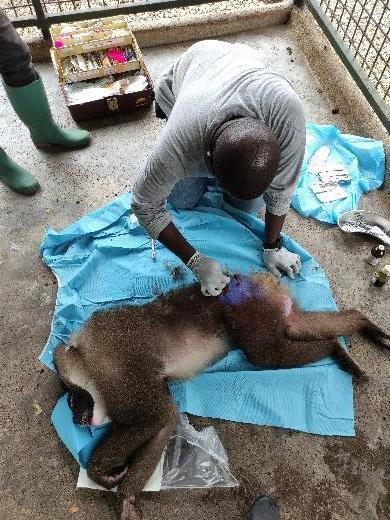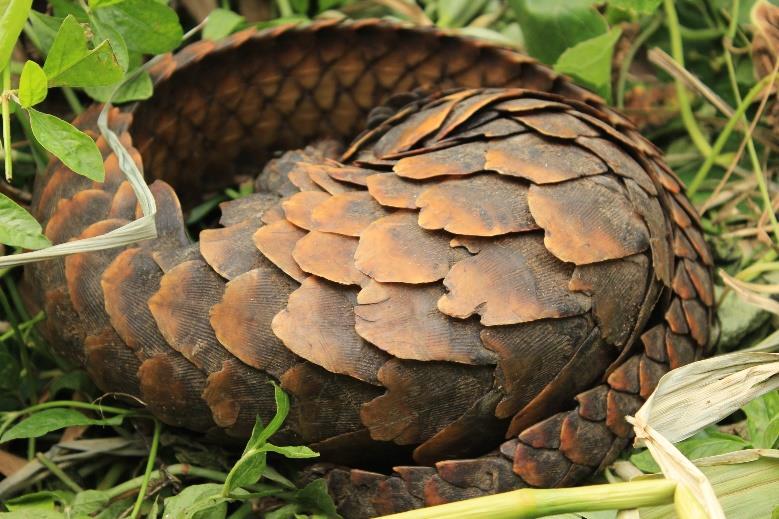
4 minute read
2. Population management & Animal welfare
Achievements March 2021 & Objectives April 2021
1. Pandrillus-GoC Partnership & Public Relations
Advertisement
Funders □ None
April 2021 objectives
□ Validate internal rules and regulations (pending) □ Review the proposal of the national strategy to rehabilitate and release the African grey parrots (pending)
2. Population management & Animal welfare
Funders
Ongoing activities
□ Maintained frequency and diversity of enrichments in each section
Specific activities
□ Red-Capped Mangabey: Water pressure cleaning of Eta’s enclosures and reenriched with wood shavings (Image 1) □ Mona Monkey: Re-enriched the cage with branches on weekly bases (Image 2) □ Putty-Nosed Monkey: Water pressure cleaning of Zulu’s enclosures and re-enriched with wood shavings □ Chimpanzee: Continued the process of the integration of Papa and Nanga in the
Mainland enclosure: introduced them to 6 new individuals of the group (Images 3-6)
□ Vet cares (March 2021): o Drill respiratory disease outbreak: Since 22nd February, the outbreak has been successfully contained but the drill section and the clinic will remain quarantined until at least the 6th April. So far, none of the analysis performed by the medical analysis laboratories was conclusive. We are looking forward to conducting further analyses. Meanwhile, we reinforced our disease surveillance efforts, and further boost the immune system of our drills with vitamins and minerals. DONATE TO OUR VETERINARY DEPARTMENT o Primates: 145 individuals treated; 4 anaesthesia performed; 15 individuals sampled (3 blood samples for haematology analysis, 3 blood samples for biochemistry analysis, 15 faecal samples for coprology analysis, 0 pus swab for microbiology analysis); 0 contraception; 0 identification with a microchip; 2 laceration repairs; 31 drug therapies: 29% antibiotics, 26% antiinflammatories, 16% dietary supplements, 10% fungicides, 6% antiparasitic, 3% painkillers and 10% others; 1 health check (1 chimpanzee); 0 death (Images
7-9)
o African grey parrots: 41 general health checks; 20 health checks before release; 20 transferrals to the soft-release aviary, 5 transferrals to the rehabilitation aviary; 8 individuals undertook minor surgery to remove cysts that prevented the regrowth of their feathers; 4 individuals received intensive care treatment with 3rd generation antibiotic treatment and special diet; 4 deaths (Images 10-11)

Image 1a&b. The Red Capped Mangabey enclosure was fully re-enriched with wood shaving, branches, elephants stalk and soybeans to stimulate natural foraging behaviour.
Image 2a&b. Foreign volunteers and the head of section, Tana Ossomba, re-enriched the Mona monkey enclosure with fresh mango branches to provide natural environment for the animals.
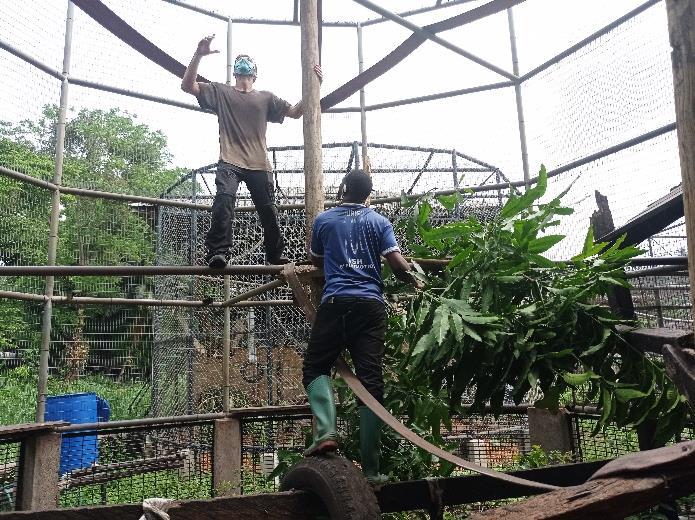
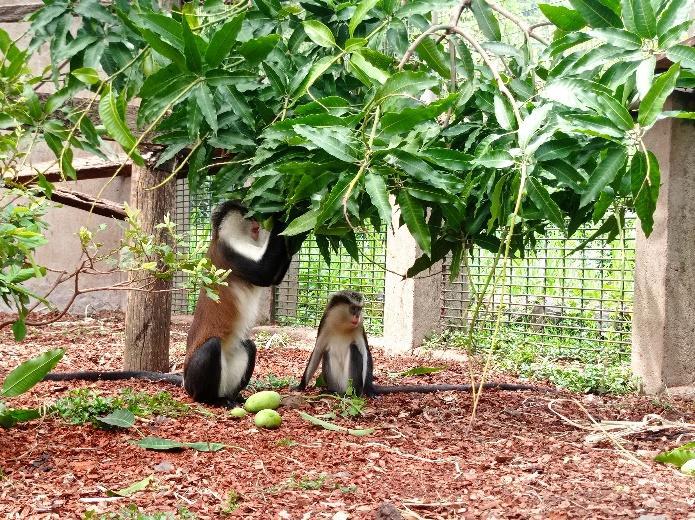
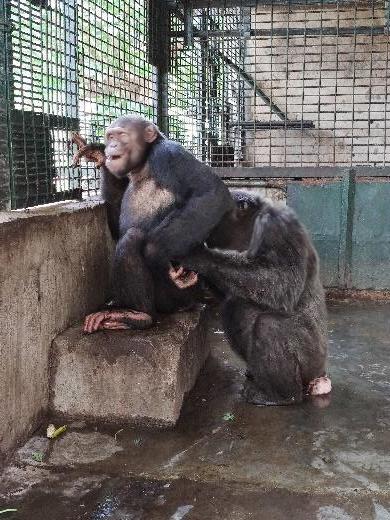
Image 3. Papaya, the dominant female of the Mainland chimp group (and the most respected individual within the group who usually bring peace and calm conflicts) was grooming introduced adult male Papa and hence created a new positive bond with him. Such affiliative behaviours are critical to ensure a successful integration.
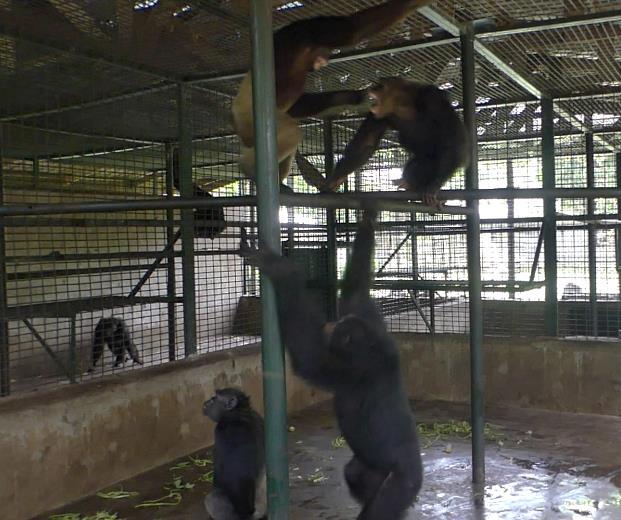
Image 5. Introduced male Nanga and Jojo are demonstrating their strength and defending their position in the hierarchy, while Jack (standing) supports his groupmate Jojo. During agnostic interactions, our team remain extremely vigilant to ensure there are no serious injuries. Grooming, play, display and aggressions are three different categories of behaviours that intervene during integration. Our role as caretakers is to mitigate aggressions and facilitate positive interaction. Image 4. Play and display also serve integration purpose to create a hierarchy without fighting. Dominance can hence be expressed without injuries.
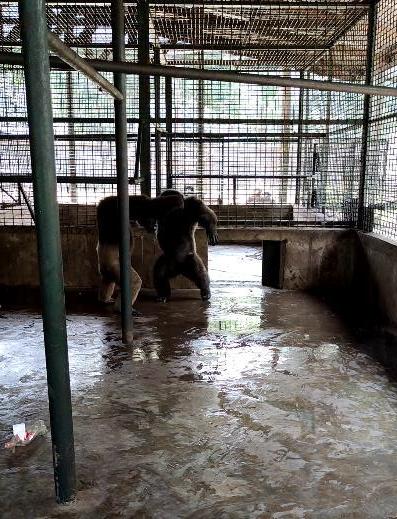
Image 6. Adult male Jojo and introduced male Papa found a quick balance and we involved in affiliative interactions, hence creating a positive link. Papa, contrary to Nanga, who is a younger adult male, is wise. He knows that despite his massive body, he will not take dominance in a highly cohesive group and hence chose to submit to others. Later, as he will create a stronger link with a few individuals, the politics and demonstration of power could lead to a change of dominance.
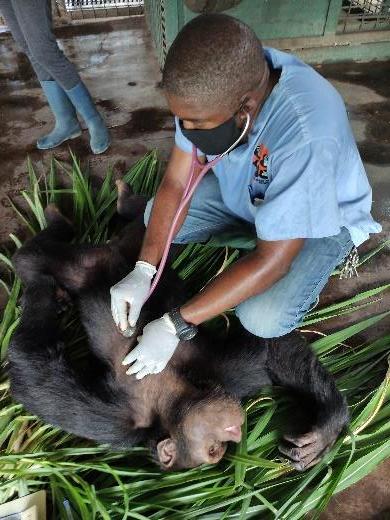
Image 7. Koto was transferred back to Island group after 08 months of intensilvely daily cares, treatments, and enrichments to treat abscessation Image 8. Malengo a challenger male undertook surgery after he injured his thumb in a fight with the Nimbus a another challenger male
Image 9a&b. Baju, an adult male challenger needed a laceration repair after a fight with on of the dominant.
Image 10. All 31 remaining individuals from the large rehabilitation aviary undertook a health check, during which their body condition, amongst other parameters, was recorded Image 11. Each bird received a fipronil treatment against parrot lice

